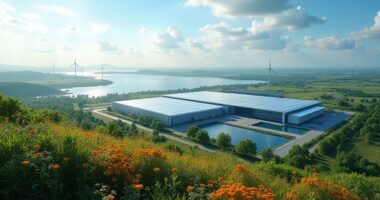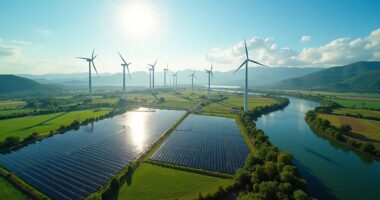In 2025, the UK’s environmental scene is looking rather green and vibrant. Thanks to the Biodiversity Net Gain Policy, new developments must boost local wildlife by 10%. Imagine solar farms blooming with wildflower meadows and wind turbines offering cozy birdhouses—yes, nature’s got a new power couple! With 680 hectares of offsite habitats created and some fantastic conservation success stories like the pine marten comeback, there’s no shortage of positive environmental progress. And there’s more—stay tuned!
Quick Overview
- The Biodiversity Net Gain policy mandates a 10% improvement in biodiversity for developments, enhancing habitat quality across the UK since February 2024.
- By early 2025, 680 hectares of off-site habitats have been created, promoting ecological balance and supporting biodiversity initiatives.
- Renewable energy projects now integrate biodiversity goals, requiring a 10% increase in local wildlife, benefiting both ecosystems and clean energy production.
- Solar farms are being developed with wildflower meadows, transforming them into biodiversity hotspots while generating substantial renewable energy.
- Successful conservation efforts, such as the pine marten reintroduction and large blue butterfly revival, highlight the UK’s commitment to protecting and enhancing biodiversity.
Advancements in Biodiversity Net Gain Policy
In recent years, the UK has taken significant strides in enhancing its Biodiversity Net Gain (BNG) policy, and it’s about time to celebrate these advancements. Mandated since February 2024, the 10% BNG requirement for developments guarantees that nature doesn’t just survive but thrives. Developers must now whip up Biodiversity Gain Plans, much like cooking a gourmet meal, using a prescribed metric to measure their ecological impact. With options like on-site habitat enhancements or off-site credits, they’re incentivized to think creatively. This approach not only focuses on measurable improvements to habitats but ensures that biodiversity is left in a better state than before. These initiatives align perfectly with established habitat protection strategies that conservationists have long advocated for as essential to maintaining ecological balance. As of early 2025, 680-hectares of offsite habitat creation have been recorded by Local Authorities, showcasing the tangible results of BNG initiatives.
Synergizing Clean Energy Projects With Biodiversity
Harnessing the power of clean energy while nurturing biodiversity isn’t just a noble idea; it’s becoming a reality across the UK.
With policies like the biodiversity net gain mandating a 10% increase in local wildlife, renewable projects must evolve into eco-friendly havens. This requirement aligns with the UK government’s Clean Power 2030 Action Plan, promoting the integration of clean energy with nature enhancement. For instance, the new solar plant linked to Ledston Primary substation is set to generate 54 GWh of solar electricity annually, significantly supporting local wildlife initiatives.
Imagine solar farms sprouting wildflower meadows, or wind turbines fostering bird boxes—nature’s version of a luxury condo!
As developers partner with planning frameworks, they’re not just generating energy; they’re cultivating thriving ecosystems. The transition to renewable sources provides significant long-term environmental benefits beyond carbon reduction.
This synergy isn’t just smart; it’s a necessary dance between clean energy and the environment, ensuring both can flourish together for years to come.
Successful Case Studies Demonstrating Positive Outcomes
Success stories in the UK’s environmental landscape are blooming like wildflowers in a sunny meadow.
The pine marten’s comeback in the Scottish Highlands showcases the power of targeted reintroduction, while Somerset’s large blue butterfly flutters back after a 1970s disappearance. Beavers are now busy reshaping wetlands across England, proving they’re nature’s eco-engineers. Beaver dams reduce flood effects by up to 60 percent, allowing for healthier ecosystems to thrive.
The revival of the pine marten and Somerset’s large blue butterfly highlights the success of conservation efforts in the UK.
Meanwhile, over 495 acres of wildflower meadows in the Cotswolds are buzzing with life, boosting rare butterfly populations. These initiatives not only restore habitats but also engage communities, creating a symphony of biodiversity that harmonizes with climate goals. These restoration projects highlight the importance of ecosystem services that healthy, diverse environments provide to human communities and wildlife alike. Additionally, pine martens help control invasive gray squirrels, further benefiting native red squirrels and enhancing overall ecosystem health. Nature’s comeback is a win-win, indeed!









